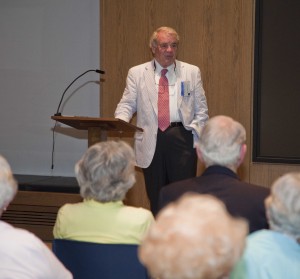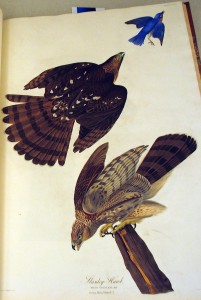 During “reunion week” (the second week of June) this year there were several opportunities to see Watkinson rarities. On Wendesday the 6th about a dozen alumni attended a presentation entitled “John James Audubon: American Dreamer.” Born in Haiti, educated in France, and sent to America to avoid the draft (i.e. Napoleon’s conscripted legions), Audubon is an early example of American self-fashioning. Works by Audubon, as well as his contemporaries Alexander Wilson and Prideaux John Selby, and his fore-runner Mark Catesby, were out on display for folks to view.
During “reunion week” (the second week of June) this year there were several opportunities to see Watkinson rarities. On Wendesday the 6th about a dozen alumni attended a presentation entitled “John James Audubon: American Dreamer.” Born in Haiti, educated in France, and sent to America to avoid the draft (i.e. Napoleon’s conscripted legions), Audubon is an early example of American self-fashioning. Works by Audubon, as well as his contemporaries Alexander Wilson and Prideaux John Selby, and his fore-runner Mark Catesby, were out on display for folks to view.
 On Friday a crowd of some 40-50 people (mostly Class of ’57) enjoyed a screening of David Elliott’s award-winning film The Curious Mr. Catesby (2007). Mr. Elliott (’57) is the Executive Director of the Catesby Commemorative Trust. I brought out the Watkinson’s copy of the first edition of Catesby’s Natural History of Carolina, Florida and the Bahama Islands (1731-43) and showed it to an appreciative crowd. Trinity was able to purchase this copy in 1883 through the generosity of a “rich uncle” of a Trinity alumnus (George Lewis Cooke, class of 1870).
On Friday a crowd of some 40-50 people (mostly Class of ’57) enjoyed a screening of David Elliott’s award-winning film The Curious Mr. Catesby (2007). Mr. Elliott (’57) is the Executive Director of the Catesby Commemorative Trust. I brought out the Watkinson’s copy of the first edition of Catesby’s Natural History of Carolina, Florida and the Bahama Islands (1731-43) and showed it to an appreciative crowd. Trinity was able to purchase this copy in 1883 through the generosity of a “rich uncle” of a Trinity alumnus (George Lewis Cooke, class of 1870).
The next day a steady stream of visitors were able to view the “bird of the week” from John James Audubon’s Birds of America set, which has been at Trinity for 112 years, as well as the newly acquired 2nd Folio of Shakespeare. At 1:30, with the help of Watkinson Trustee Jack Enders (’92), I presented a selection of recent acquisitions of ornithology material for the Enders collection, given by his grandfather, Ostrom Enders in the 1980s.




